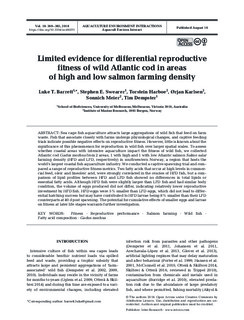| dc.description.abstract | Sea cage fish aquaculture attracts large aggregations of wild fish that feed on farm waste. Fish that associate closely with farms undergo physiological changes, and captive feeding trials indicate possible negative effects on reproductive fitness. However, little is known about the significance of this phenomenon for reproduction in wild fish over larger spatial scales. To assess whether coastal areas with intensive aquaculture impact the fitness of wild fish, we collected Atlantic cod Gadus morhua from 2 areas, 1 with high and 1 with low Atlantic salmon Salmo salar farming density (HFD and LFD, respectively) in southwestern Norway, a region that hosts the world’s largest coastal fish aquaculture industry. We conducted a captive spawning trial and compared a range of reproductive fitness metrics. Two fatty acids that occur at high levels in commercial feed, oleic and lineoleic acid, were strongly correlated in the ovaries of HFD fish, but a comparison of lipid profiles between HFD and LFD fish showed no differences in total lipids or essential fatty acids. Although HFD fish were slightly larger than LFD fish and had similar body condition, the volume of eggs produced did not differ, indicating relatively lower reproductive investment by HFD fish. HFD eggs were 5% smaller than LFD eggs, which did not lead to differential hatching success but may have contributed to HFD larvae being 8% smaller than their LFD counterparts at 40 d post spawning. The potential for cumulative effects of smaller eggs and larvae on fitness at later life stages warrants further investigation. | nb_NO |
